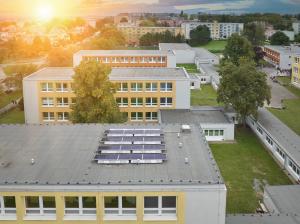Duro-Last Highlights Factory-Based Manufacturing Process Designed for Consistency in Commercial Roofing
Prefabricated systems manufactured under controlled conditions deliver the kind of reliability field fabrication cannot guarantee”
WISCONSIN RAPIDS, WI, UNITED STATES, September 30, 2025 /EINPresswire.com/ -- Consistency and reliability remain central to long-term roof performance, especially in commercial applications where durability and efficiency are critical. Roofing manufacturer Duro-Last has developed a factory-based production process that emphasizes uniformity, prefabrication, and rigorous quality control to address these challenges.— Thad Brown
Unlike traditional roll roofing materials fabricated primarily on job sites, Duro-Last roofing systems are manufactured in controlled environments. This approach allows for precision cuts, welded seams, and custom fittings produced under stable conditions. By creating large sections of roofing membranes to exact project specifications, field seams are minimized, reducing one of the most common sources of roof leaks and long-term failures.
From Material to Membrane
The manufacturing process begins with polyvinyl chloride (PVC), selected for its flexibility, durability, and resistance to chemicals, punctures, and weathering. A reinforcement scrim is laminated within the PVC to provide dimensional stability and strength. Each roll of material undergoes inspection to ensure uniform thickness and composition before moving into prefabrication.
Prefabrication represents one of the defining aspects of the system. Roofing sections are cut and welded in the factory, measured precisely for the project at hand. Corners, curbs, and penetrations are produced in the same controlled environment, reducing the need for on-site customization. With fewer cuts and welds made on rooftops, installation becomes more predictable and less dependent on variable field conditions.
Industry Perspective
“More than forty years in roofing have shown that consistency is the key to durability,” said Thad Brown, owner and founder of Dynamic Alliance Roofing LLC in Wisconsin Rapids, Wisconsin. “Prefabricated systems manufactured under controlled conditions deliver the kind of reliability field fabrication cannot guarantee.”
Built-In Quality Control
Multiple checkpoints exist throughout the factory process to confirm performance standards. Raw materials undergo testing before production, and heat-welded seams are evaluated for strength, watertight performance, and resistance to stress. Every stage of manufacturing integrates inspection, with factory technicians trained to identify and address irregularities early in the process.
This factory-based approach contrasts with rooftop fabrication, where weather, dust, and uneven surfaces can affect seam quality and overall precision. By shifting fabrication into controlled conditions, variability is reduced, and roofing systems leave the factory already prepared to perform.
Environmental Considerations
Energy performance and sustainability also play a role in the production model. Reflective membranes are designed to limit heat absorption, improving energy efficiency for buildings in hot climates. Duro-Last systems are also recyclable at the end of their service life, and production practices are structured to minimize waste during fabrication. These elements align with ongoing industry efforts to integrate sustainable construction methods without compromising durability.
Installation Advantages
Prefabrication contributes directly to installation outcomes. Large, pre-welded sheets arrive at job sites ready for placement, requiring fewer on-site seams and adjustments. Installers work with components tailored to a building’s dimensions, which reduces variability from project to project. In practice, this means installations are cleaner, safer, and less prone to human error.
Fewer seams also translate into fewer opportunities for leaks, one of the most common issues in flat and low-slope roofing. This emphasis on precision before materials arrive on-site allows installation crews to work more efficiently while maintaining performance standards.
Meeting Industry Demands
The commercial roofing industry faces ongoing challenges, from changing weather patterns to heightened performance requirements. Factory-based manufacturing and prefabrication represent a response to these demands, creating systems designed to withstand diverse climates while meeting expectations for consistency.
Brown, who has observed the industry evolve over decades, emphasized how the approach reflects a larger trend. “Prefabricated systems manufactured in controlled conditions deliver the kind of reliability field fabrication cannot guarantee,” he said. “It’s a shift that has transformed expectations for both installers and building owners.”
Long-Term Performance
For property owners and facility managers, the advantages of factory-based roofing systems extend beyond initial installation. Reduced variability, consistent quality, and controlled manufacturing all contribute to extended roof performance. By limiting field fabrication, the systems are less exposed to the risks that typically affect roofing outcomes.
In addition to durability, energy efficiency benefits contribute to long-term value. Reflective membranes lower cooling costs, while recyclable materials support sustainability goals. These features illustrate how roofing has expanded beyond basic protection, becoming part of broader strategies for efficiency and resilience in commercial construction.
Industry Outlook
As commercial buildings face greater demands for energy performance, durability, and sustainability, systems built for consistency are gaining wider recognition. Prefabricated roofing assemblies produced under controlled factory conditions provide a model that addresses these concerns in a single process.
The approach represents more than a shift in technique; it signals a broader redefinition of roofing standards. With consistency, precision, and durability as guiding principles, factory-based systems highlight how manufacturing innovation can influence building performance across industries.
Morgan Thomas
Rhino Digital, LLC
+1 504-875-5036
email us here
Visit us on social media:
Facebook
Legal Disclaimer:
EIN Presswire provides this news content "as is" without warranty of any kind. We do not accept any responsibility or liability for the accuracy, content, images, videos, licenses, completeness, legality, or reliability of the information contained in this article. If you have any complaints or copyright issues related to this article, kindly contact the author above.


